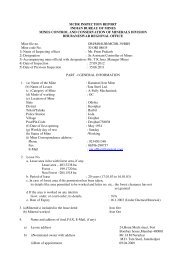Market Survey on Copper - Indian Bureau of Mines
Market Survey on Copper - Indian Bureau of Mines
Market Survey on Copper - Indian Bureau of Mines
You also want an ePaper? Increase the reach of your titles
YUMPU automatically turns print PDFs into web optimized ePapers that Google loves.
a large extent by volatisati<strong>on</strong> <strong>of</strong> their sulphides during slag forming stage <strong>of</strong><br />
c<strong>on</strong>verting i.e. before metallic copper is formed. In c<strong>on</strong>tinuous operati<strong>on</strong>s,<br />
since metallic copper is always present, these impurities get dissolved in copper<br />
before volatilisati<strong>on</strong> can occur. The eliminati<strong>on</strong> <strong>of</strong> these impurities is difficult<br />
by further pyrometallurgical operati<strong>on</strong>s because <strong>of</strong> their low chemical activities.<br />
This is the reas<strong>on</strong> why the anodes from c<strong>on</strong>tinuous operati<strong>on</strong> have higher level<br />
<strong>of</strong> As, Bi and Sb necessitating more careful electro-refining. Therefore, the<br />
c<strong>on</strong>tinuous smelting route is restricted to smelting <strong>of</strong> c<strong>on</strong>centrate with less<br />
c<strong>on</strong>tent <strong>of</strong> these impurities.<br />
3.2.4 New and Emerging Processes<br />
3.2.4.1 Foam Smelting<br />
A stati<strong>on</strong>ary furnace with water cooled side walls, similar to<br />
zinc fuming furnace is employed. A layer <strong>of</strong> slag-matte foam is<br />
maintained above a quiescent bath <strong>of</strong> slag and matte/metal. C<strong>on</strong>centrate,<br />
flux and carb<strong>on</strong>aceous fuel are fed into the foam layer maintained in a<br />
highly turbulent c<strong>on</strong>diti<strong>on</strong> by oxygen-enriched air blown through tuyers.<br />
When blowing stops, the foam subsides exposing the tuyers directly<br />
above the bath. The slag and matte/metal c<strong>on</strong>tinuously overflow from<br />
the furnace through weirs. Provisi<strong>on</strong> is made for cleaning the slag by<br />
reducti<strong>on</strong> in a separate secti<strong>on</strong> <strong>of</strong> the furnace.<br />
3.2.4.2 Electrolytic Refining<br />
Electrolytic refining involves electrochemically dissolving<br />
copper from impure anodes and selectively plating the dissolved pure<br />
copper <strong>on</strong> to copper cathodes. During the process, it eliminates<br />
electrically and mechanically harmful impurities and at the same time<br />
separate valuable impurities which can be recovered as byproducts.<br />
The principal impurities in a copper anode are As, Bi, Ni, Pb, Sb, Se, Te,<br />
Au, Ag and Pt. Gold and platinum do not dissolve in the sulfate electrolyte and<br />
hence they remain as anode residue/slimes. Silver partially dissolves but is<br />
precipitated from the electrolyte as AgCl by dissolving a small amount <strong>of</strong> NaCl<br />
or HCl in the electrolyte. Sulphur, selenium and tellurium being present as<br />
Ag2Se, Cu2Se, Ag2Te4 and Cu2S are not dissolved in electrolyte and therefore<br />
report in anode residue/slimes in a similar fashi<strong>on</strong> as noble metals. Lead and tin<br />
forming insoluble sulphates do not enter electrolyte to any appreciable extent.<br />
The other impurities (As, Bi, Co, Fe, Ni and Sb) being less noble than copper,<br />
dissolve in the electrolyte and therefore must be removed from the electrolyte to<br />
avoid c<strong>on</strong>taminati<strong>on</strong> <strong>of</strong> cathode copper by occlusi<strong>on</strong>.<br />
Cleaning <strong>of</strong> electrolyte involves three main sequential steps:<br />
a) Removal <strong>of</strong> copper from the electrolyte by electro-winning using inert<br />
antim<strong>on</strong>ial lead anodes and normal copper starting sheets.<br />
b) Removal <strong>of</strong> arsenic antim<strong>on</strong>y and bismuth by electro-winning them into an<br />
impure copper cathode deposit.<br />
41
















